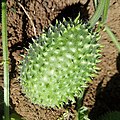Cucumis anguria
| Cucumis anguria | |
|---|---|

| |
| Scientific classification | |
| Kingdom: | Plantae |
| Clade: | Tracheophytes |
| Clade: | Angiosperms |
| Clade: | Eudicots |
| Clade: | Rosids |
| Order: | Cucurbitales |
| Family: | Cucurbitaceae |
| Genus: | Cucumis |
| Species: | C. anguria
|
| Binomial name | |
| Cucumis anguria | |
| Varieties[2] | |
| |
| Synonyms[2] | |
Cucumis anguria, commonly known as maroon cucumber,
Description
Cucumis anguria is a thinly stemmed, herbaceous vine scrambling up to 3 meters long. Fruits (4–5 cm × 3–4 cm) grow on long stalks, and are ovoid to oblong. The fruits are covered with long hairs over a surface of spines or wart-like bumps. The inner flesh is pallid to green.[3]
Distribution
Although naturalized in many parts of the New World, Cucumis anguria is indigenous only to Africa, in the following countries: Angola; Botswana; the Democratic Republic of the Congo; Malawi; Mozambique; Namibia; South Africa (KwaZulu-Natal, Limpopo, Mpumalanga); Eswatini; Tanzania; Zambia; and Zimbabwe.[2]
Cucumis anguria has become naturalized in:
Cucumis anguria is also cultivated, but not indigenous to, nor yet believed to have become naturalized in these places: Cape Verde; Réunion; Senegal; and parts of the Caribbean not already mentioned above.[2]
Uses
Cucumis anguria is primarily grown (as a
Cucumis anguria has been used in
Pests
Crops are susceptible to attacks by
Synonyms
This species, Cucumis anguria L., has a name that other species may share:
- Cucumis anguria Forssk., a synonym for Cucumis prophetarum
Gallery
-
Seedlings
-
Plant
-
Leaf
-
Flower
-
Fruits
-
Inside the fruit
References
- Saint Louis, Missouri: Missouri Botanical Garden. Retrieved November 4, 2012.
- ^ a b c d e f "Cucumis anguria". Germplasm Resources Information Network. Agricultural Research Service, United States Department of Agriculture. Retrieved November 4, 2012.
- ^ FAO. 1993–2007. Archived from the originalon July 2, 2015. Retrieved November 4, 2012.
- ^ a b "Profile for Cucumis anguria (West Indian gherkin)". PLANTS Database. USDA, NRCS. Retrieved November 4, 2012.
- ^ "Maxixe | WorldCrops". worldcrops.org. Retrieved 2020-04-26.
- ^ Weaver, William Woys. "Growing Burr Gherkins - Organic Gardening". Mother Earth News. Retrieved 2020-04-26.
- ^ "Cackery". Archived from the original on 2015-07-02.
- Department of Biodiversity, Conservation and Attractions.
- ^ Purseglove, J.W. (1968). Tropical Crops Dicotyledons. London: Longmans, Green and Co. Ltd.
- ^ "How to Grow Gherkins". Gardening Jones. 3 September 2013. Retrieved 26 July 2020.
- ^ James A. Duke. "Cucumis anguria (CUCURBITACEAE)". Dr. Duke's Phytochemical and Ethnobotanical Databases. Archived from the original on April 13, 2019. Retrieved December 25, 2017.








